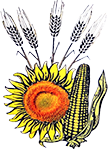Research Concerning Sunflower Soil Pests Control, in the South-East Of Romania
Emil Georgescu1, Maria Toader2, Lidia Cană1, Luxița Râșnoveanu3,4, Georgeta Trașcă5
1Institutul Național de Cercetare Dezvoltare Agricolă Fundulea
3Universitatea de Științe Agronomice și Medicină Veterinară București
3Stațiunea de Cercetare-Dezvoltare Agricolă Brăila
4Academia de Studii Economice, Facultatea de Economie Agroalimentară și Ingineria Mediului, București
5Staţiunea de Cercetare și Dezvoltare Agricolă Piteşti
Keywords: sunflower, pests, control, treatment.
Abstract: This study has tested possible alternatives for sunflower seed treatment with neonicotinoids, for controlling the maize leaf weevil (Tanymecus dilaticollis) and darkling beetle (Opatrum sabulosum). The experience was carried out at the National Agricultural Research and Development Institute, Fundulea, in the southeast of Romania, in the years 2021 and 2022. This study has tested seed treatment with cypermethrin active ingredient, seed treatment with cypermethrin active ingredient, followed foliar treatment with cu deltamethrin or acetamiprid, seed treatment with neem oil, and treatment with a biological insecticide on the base of Beauveria bassiana entomopathogen fungus, in two doses. It has assessed maize leaf weevil and darkling beetle, after the complete emergence of sunflower (BBCH 10) and four leaves stage (BBCH 14). Also, when sunflower plants were in for leaves stage (BBCH 14), it assessed maize leaf weevil attack intensity, on a scale from 1 (plants not attacked) to 9 (plants destroyed). In the spring of the year 2021, it was ascertained that the density of maize leaf weevils (T. dilaticollis) adults was higher than the economic damage threshold (PED=5 weevils/m2), both at sunflower complete emergence (BBCH 10), and four leaves stage (BBCH 14). In the spring of the year 2022, only at complete sunflower plant emergence (BBCH 10) density of the maize leaf weevil was higher than the economic damage threshold. Regarding as darkling beetle, the higher density of the adults of this species, it has registered in the spring of the year 2022. In this study, in both years, it hasn't registered significant statistical differences concerning maize leaf weevil and darkling beetle density between treated variants and control (untreated) variants. Regarding maize leaf weevil attack intensity at sunflower plants, in the spring of the year 2021, ranged from 4.49 to 4.67 while in the spring of the year 2022, ranged from 3.54 to 3.75. In both years it hasn't registered significant statistical differences between maize leaf weevil attack intensity at the control (untreated) sunflower variant and treated variants. The results of this experience make evidence that all tested treatments can’t be an alternative to seed treatment with neonicotinoids for controlling the maize leaf weevil and darkling beetle in the climatic conditions from the southeast of Romania.
